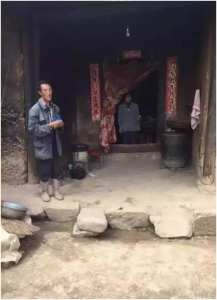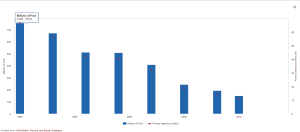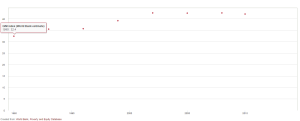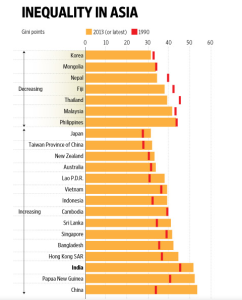Last week, an article titled “Ants in The Prosperous Era” went viral on WeChat and Microblog, China’s most popular social platforms. All of a sudden, we all know that a woman named Gailan Yang killed her four young children behind her small, mud-brick house in a poor northwestern Chinese village in Gansu Province with an ax and the woman drank pesticide to kill herself later. Gailan’s husband who earned a life hardly outside the village with no more than $20 a day of income committed suicide after learning what happened.
(Gailan’s bedroom)
Over half of the population is under the poverty line in the village where Gailan struggled to live since she got married at the age of 19. According to the article, qualified as exceptionally poor, Gailan spent her days working in the fields “hopelessly.” Gailan took care of her four children in this 10-square-meter wind-blown dangerous house. What’s worse, all of her four children could not be registered with a “Hukou,” official residential permit in China, which means the children could not enjoy the country’s social welfare benefit.
“If there’s no incident like Gailan Yang killing her whole family, who would believe that these disadvantaged people and groups still exist in this prosperous era?” questioned the author, a well-known commentator.
As the world’s second-largest economy, China is among the world’s worst in income inequality. The country’s poverty rate dropped from 88 percent in 1981 to 11 percent in 2014, according to the World Bank.
Yet more than 70 million people in China still live below the poverty line, according to the National Bureau of Statistics, and income inequality is becoming larger and larger. The richest 1 percent of China’s households own a third of the country’s wealth, according to a recent report by Peking University. The poorest 25 percent of Chinese households own just 1 percent of the country’s total wealth, the study found.
Gini coefficient is a widely acknowledged measure of inequality that takes into account income distribution among residents of a country. The higher the Gini coefficient, the greater the inequality is. 40 or 0.4 is the warning level set by the United Nations. As it shown in the graph, China’s Gini coefficient rose to 49 in 2009, from 32 in 1990(the number varies among official statistics and organizational statistics). According to China’s official statement, China has made a great progress in combating inequality, making the lowest number of Gini Index in 2015. However, the number is still expected to be larger in reality.
Among Asian countries, China has ranked the first in earning Gini points speedily according to IMF. This May, IMF warns of growing inequality in India and China. IMF points to the problem with redistribution of incomes as high growth rates are not reducing inequality.
“When a person commits a crime for bread, then society is to blame,” one user wrote on Weibo, China’s version of Twitter. Although it’s discriminating to call people ants in the article, the family killing does shock the whole China’s society and raise an alarm to the abnormal economic development in current China.






Leave a Reply
You must be logged in to post a comment.